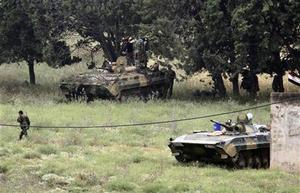SyriaChemical munitions used in 8/21 attack carried larger payload than previously estimated
A new study of the 21 August chemical attack on rebel-controlled areas on the outskirts Damascus found that that the rockets used in the attack carried larger toxic payloads than had previously been estimated. Weapons experts say that the fact that the rockets carried up to fifty times more sarin nerve agent than previously thought helps explain why there were so many more victims than in previous chemical attacks by regime forces.

Syria's Fourth Armored Division on maneuvers // Source: akhbaralarab.net
A new study of the Syrian army’s 21 August chemical attack on rebel-controlled areas on the outskirts Damascus found that that the rockets used by the 155th Brigade of the 4th Armored Division of the Syrian Army — a division under the command of the Syrian president’s brother, Maher Assad — carried larger toxic payloads than had previously been estimated. The munitions were prepared by the Syrian Army’s Unit 450, which controls Syrian chemical weapons.
Weapons experts say that the fact that the rockets carried up to fifty times more sarin nerve agent than previously thought helps explain why there were so many more victims than in previous chemical attacks by regime forces.
The New York Times reports that the leading weapons experts who wrote the study say that the mass of toxic material could have come only from a large stockpile — that is, from the Syrian army’s chemical weapons depots. They say that the anti-regime rebels do not have the capabilities to produce such large quantities of lethal toxins.
Syria has the world’s largest chemical weapons stocks.
The study was written by Richard M. Lloyd, an expert in warhead design at the Arlington, Virginia-based Tesla Laboratories, and Theodore A. Postol, a physicist at the Massachusetts Institute of Technology.
The two weapons specialists told the Times that their analysis of images of rocket parts and wreckage posted online suggested that the warheads carried toxic payloads of about fifty liters (thirteen gallons), not the one or two liters (up to half a gallon) of nerve agent that some weapons experts had previously estimated.
“It’s a clever design,” Dr. Postol said of the munitions in an interview. “It’s clever not only in how it was implemented but in the effectiveness of its dispersal. It accounts for the large number of causalities.”
“I have no information about how many canisters were fired and no information about where they landed,” Postol told Deutche Presse-Agentur, according to News24. “But if you are trying to make a circumstantial argument that more people were killed, this certainly supports that.”
He said he and Lloyd were just “trying to figure out what happened on the ground.”
